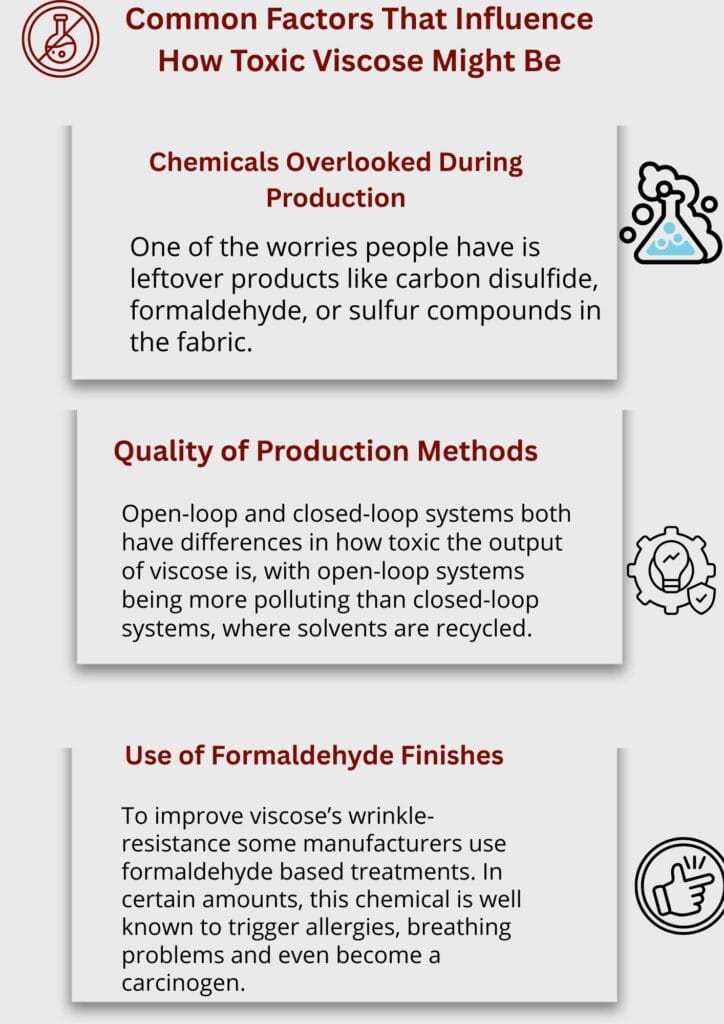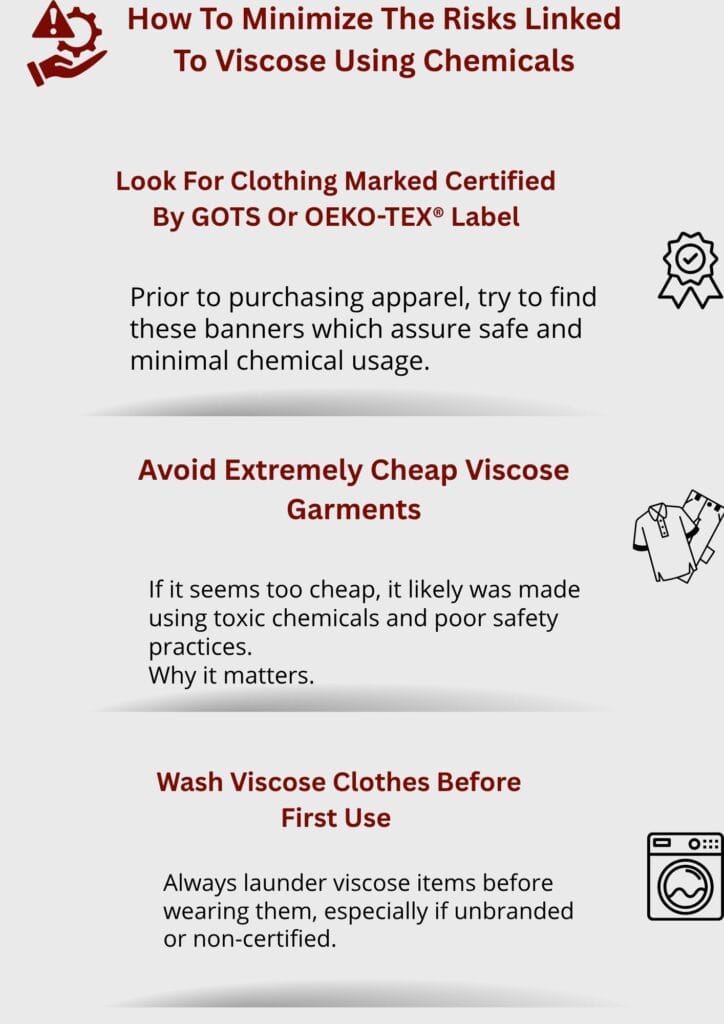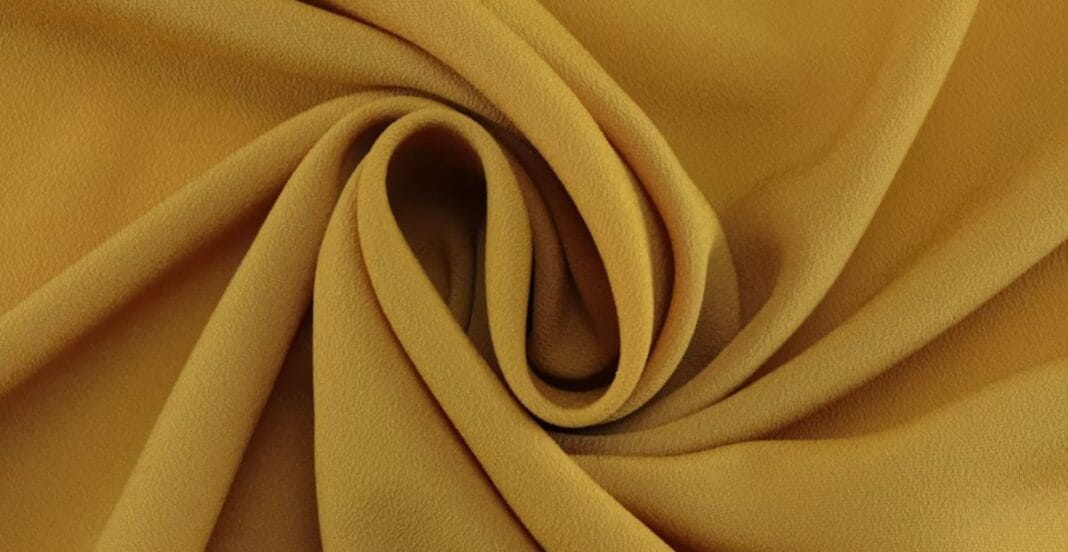Introduction
Viscose, or rayon, is a widely-used semi-synthetic fabric derived from wood pulp. It is commended for being inexpensive, breathable, and having a silk-like texture. Nonetheless, its manufacturing viscose has raised concern for potential health issues.
This presents an essential issue: Is there any health risks associated with viscose, or is it safe to use everyday? Many consumers, particularly those mindful of their health and ecology, find themselves lost in contradictory statements.
In this article, we address the production process of viscose, analyze the fabric for health risks, compare it with other fabrics, and discuss other relevant questions. This guide is for those curious about the story behind soft and flowy dresses, blouses and other garments.
How Viscose is Made: The Chemical Process of Fabric Production
The initial product for viscose production is natural; wood pulp from beech, pine or eucalyptus trees. However, fabric creation requires a series of intricate chemical processes starting with wood treatment. The wood is treated with sodium hydroxide, which transforms it into alkali cellulose. It is later aged before undergoing additional treatment with carbon disulfide to from a substance called cellulose xanthate.
This solution is further treated with sodium hydroxide to form a viscous dough-like substance referred to as viscose. Lastly, the viscose undergoes extrusion through spinnerets into a bath of sulfuric acid, where it solidifies into fibers.
Toxic Byproducts and Environmental Risks
This complex and chemically-intensive process gives rise to a wide range toxic byproducts such as hydrogen sulfide, carbon disulfide, and heavy metals in some factories. These byproducts, if unmanaged, pose risks to workers and local ecosystems.
Comparison with Other Semi-Synthetic Fabrics
Viscose is often accompanied with modal and TENCEL® (lyocell). Although they all originate from cellulose, TENCEL® is far less polluting and significantly safer for workers and the environment, thanks to a closed-loop system which reuses almost all solvents.
Is Viscose Toxic to Wear? Understanding Safety Concerns
The positive news is that wearing viscose is not considered toxic for the majority of individuals. The caveat, however, is that and how it is manufactured greatly influences the safety level.
Skin Irritation from Residual Chemicals
Inexpensive viscose fabrics are likely to contain leftover formaldehyde or carbon disulfide, which can lead to skin irritation for sensitive individuals and those with allergies. While more expensive brands are likely to thoroughly wash the fabric, this is not the case for fast fashion items.
Breathing Issues Are an Issue for Manufacturers
Factory workers can develop breathing issues due to airborne carbon disulfide in inadequately monitored workplaces. The good news, however, is that the fabric does not emit harmful vapors and is safe for use by consumers.
Formaldehyde: A Concealed Substance in Brand Names
Some garments made from viscose might be labeled as wrinkle-resistant due to the use of formaldehyde. This substance is an irritant and a possible carcinogen in large amounts, which heightens risk concerns. Remember to look for certifications or wash all new clothing prior to wearing them.
Personal Toxicity vs Eco-Toxicity
While it is likely safe for individuals to wear viscose, its production can be toxic for ecosystems. Manufacturing zones are known to polluted water sources and contaminate air—these have long-lasting environmental consequences for populations living near these factories.
Is Viscose More Toxic Than Other Fabrics?
In approaching the question, “Is viscose toxic,” it is useful to evaluate it alongside other common textiles. Not all fabrics are created equal.
Conventional Cotton: The Pesticide Epidemic
Cotton is classified as a natural fiber, however, conventional cotton farming is notorious for large-scale use of pesticides and fertilizers. These chemicals are dangerous for the environment as well as farmworkers. embora, the cotton fabric is usually safe to wear, but the environmental toll is high.
Bamboo Viscose: Not As Natural As It Sounds
Though the name ‘bamboo’ might suggest environmental friendliness, the process for obtaining bamboo viscose is as damaging as that of regular viscose. As with many products, the bamboo viscose marketed as ‘eco-friendly’ is only devoid of harmful chemicals if produced with closed-loop systems.
TENCEL® (Lyocell): A Safer, Eco-Friendly Option
TENCEL® or Lyocell is produced from a non-toxic and recyclable solvent NMMO. This closed-loop system has a reusability of over 99% of chemicals making it one of the most eco-friendly and safest alternatives to viscose.
Polyester: Different Risks, Like Microplastics
While polyester is not created by dissolving solvent chemicals, it is a fiber made from plastic. During washing, polyester releases microplastics into waterways, adding to ocean pollution. Unlike cotton or viscose, polyester is also non-biodegradable.
Are There Alternative Viscose Materials That Are Safer?
The question “is viscose toxic” becomes more complex when looking at certifications and alternatives to the fabric.
OEKO-TEX® Certified Viscose
Viscose with an OEKO-TEX® certification has undergone testing for harmful chemicals, and thus, is safe for human use. This certification viscose grade assures chemical residues, if any, remain at safe thresholds.
TENCEL® Lyocell: Clean and Green
As stated above, TENCEL® uses a closed-loop, non-toxic system for production, and it is less water and energy intensive. For those seeking the softness of viscose without its attendant toxicity, TENCEL® is the option of choice.
Organic Linen or Hemp
Both are natural, breathable, and light on chemicals. More importantly, they are non-toxic, biodegradable and therefore, perfect for health-conscious users.
How to Choose Safer Viscose Clothing
Not all viscose is created equally, and here’s what you can do to make safer choices.
Seek Out Known Certifications
Always look out for labels such as OEKO-TEX®, GOTS, or FSC (Forest Stewardship Council). These certifications confirm that the fabric is safe, sustainably sourced, and free from harmful chemicals.
Prefer Brands That Use Closed Loop Systems
Brands using closed-loop viscose production tend to be less toxic and more eco-friendly with their clothing. Thus, these brands help lessen environmental harm while guaranteeing safer clothing.
Wash Before Wearing
Washing new viscose garments helps eliminate any traces of chemicals from the finishing process used by manufacturers. For safety, you should always wash new viscose clothes before putting them on.
Common Myths About Viscose Toxicity
A lot of myths revolves around the topic of viscose which only adds to the confusion and fear.
“Ah Viscose Is Toxic” Is False
Not all viscose is dangerous, in fact many high-quality viscose garments are safe and certified. The problem lies in how cheap viscose garments are produced. These low quality dresses do contain harmful residues, but not all viscose is dangerous.
“Bamboo Viscose is Natural and Chemical-Free” – Is Also False
Bamboo derived products are often considered pure by many which is not the case. It goes through the same toxic chemical process as regular viscose. Thus, to label it as “natural” is misleading.”
“Viscose is Same as Cotton” – False It is Misleading
Though cotton and viscose do have a botanical origin, they are very different. Cotton is mechanically processed, while viscose undergoes a chemical alteration, making their toxicity and environmental profiles very different.
Common Factors That Influence How Toxic Viscose Might Be

Chemicals Overlooked During Production
One of the worries people have is leftover products like carbon disulfide, formaldehyde, or sulfur compounds in the fabric. Striving for efficiency in fast fashion brands may overlook timely washing and finishing steps due to their high production demands.
Quality of Production Methods
Open-loop and closed-loop systems both have differences in how toxic the output of viscose is, with open-loop systems being more polluting than closed-loop systems, where solvents are recycled. Closed-loop systems are far less toxic to the environment.
Use of Formaldehyde Finishes
To improve viscose’s wrinkle-resistance some manufacturers use formaldehyde based treatments. In certain amounts, this chemical is well known to trigger allergies, breathing problems and even become a carcinogen.
How To Minimize The Risks Linked To Viscose Using Chemicals

Look For Clothing Marked Certified By GOTS Or OEKO-TEX® Label
Prior to purchasing apparel, try to find these banners which assure safe and minimal chemical usage.
Why it matters: These certifications test for substances like formaldehyde, heavy metals, and phthalates. They confirm that your clothing is safe for direct skin contact.
Avoid Extremely Cheap Viscose Garments
If it seems too cheap, it likely was made using toxic chemicals and poor safety practices.
Why it matters: Low-cost brands often skip safety protocols, leaving harmful chemical residues in the final product.
Wash Viscose Clothes Before First Use
Always launder viscose items before wearing them, especially if unbranded or non-certified.
Why it matters: Washing can remove chemical finishes and reduce skin irritation risks from residue.
Environmental Impact of Viscose: Beyond Personal Toxicity
The environmental impact of viscose is severe and should be investigated. Healthwise, it can have significant footprints.
Deforestation Due to Wood Pulp Gathering
Viscose production starts with wood pulp, which, if not obtained from FSC-certified forests, can lead to deforestation. Irrespective of the source, forest depletion fuels climate change while simultaneously destroying natural habitats.
Factory-Caused Water Pollution
Factories that produce viscose wastes several untreated chemicals which when discharged into the rivers and lakes untreated contaminate water. This not only pollutes water but also endangers aquatic animals and raises the risk of waterborne diseases for nearby communities.
Biodegradability Benefits Viscose
Biodegradability is a key advantage of viscose over synthetic fibers, particularly polyester. Still, if the production process is harmful to the environment, then biodegradability does not offset the environmental damage.
Conclusion
So, is viscose toxic? It’s definitely not a yes or no situation.
Absorbing chemicals used in the production processes of cheap viscose can be an irritant to some burn sensitive skin or cause allergies. This makes the garment viscose toxic. To wear. Considerably cheaper and unbranded alternatives are far more unsafe than claimed to be.
Eco-friendly fabrics are better choices. For safer options, look for OEKO-TEX®, GOTS, or FSC certifications. For an even safer choice more expensive options like TENCEL®, organic hemp, or linen are available.


